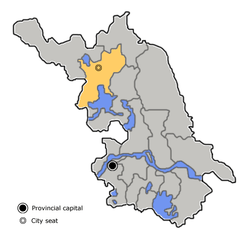Suqian
| Suqian 宿迁市 | |
|---|---|
| Prefecture-level city | |
|
| |
 Location of Suqian City (yellow) in Jiangsu | |
 Suqian Location in China | |
| Coordinates: 33°56′N 118°17′E / 33.933°N 118.283°ECoordinates: 33°56′N 118°17′E / 33.933°N 118.283°E | |
| Country | People's Republic of China |
| Province | Jiangsu |
| Government | |
| • Mayor | Wang Tianqi (王天琦) |
| Area | |
| • Prefecture-level city | 8,555 km2 (3,303 sq mi) |
| Population (2011) | |
| • Prefecture-level city | 4,730,000 |
| • Metro | 735,000 |
| Time zone | UTC+8 (China Standard) |
| Postal code |
223800 (Urban center) 223600, 223700, 223900 (Other areas) |
| Area code(s) | 527 |
| ISO 3166 code | CN-JS-13 |
| GDP | ¥193.6 billion (2011) |
| GDP per capita | ¥40,930 (2011) |
| Major Nationalities | Han |
| County-level divisions | 5 |
| Township-level divisions | 115 |
| License Plate Prefix | 苏N |
| Website |
www |
Suqian (simplified Chinese: 宿迁; traditional Chinese: 宿遷; pinyin: Sùqiān, IPA: [sû.tɕʰjɛ́n]) is a prefecture-level city in northern Jiangsu Province, People's Republic of China. It borders Xuzhou to the northwest, Lianyungang to the northeast, Huai'an to the south, and the province of Anhui to the west.
History

Suqian was said to be the site of a military grain store built when the Emperor Yuan of Jin reigned. Thus, the former Xiaxiang county where the store located was renamed Suyu (宿預; means "prepared" or "usually prepared") in 405. Then the county was annexed by Xuzhou and renamed Suqian in 762 because the homophone "yu (豫)" as the given name of the Emperor Daizong of Tang was deemed to be ineffable.[1] The county was put under the jurisdiction of Huaiyang military prefecture druing the Song dynasty, then was transferred to Pizhou after Jurchen's Jin took it. The county was administered by Huai'an military prefecture during 1272–75, but restored as a part of Pizhou afterwards. It was annexed by Xuzhou again in 1733. Then it was put under the jurisdiction of Huaiyin in 1934. The county was converted as a county-level city in 1987, later was elevated to prefecture status in 1996.[2]

Geography
Suqian possesses the most of Luoma Lake, which is a major lake in the Huai River valley.
Demographics
By the end of 2016, Suqian had a recorded population of about 5.92 million and a resident population of about 4.88 million.[3]
Economy
Local Yanghe along with Moutai and Wuliangye, are the three biggest manufacturers of baijiu.[4] Besides, several domestic companies followed JD.com to site their call centres in Suqian.
Transport
Roads
Expressways
Rail
Yanghe Station, known as Suqian Station on Suqian–Huai'an Railway is located in the south outskirt of Suqian.
Education
Suqian College is the single institution in Suqian providing bachelor's degree education.
Administration
The prefecture-level city of Suqian administers 5 county-level divisions, including 3 counties and 2 districts.
These are further divided into 115 township-level divisions, including 111 towns and township, and 4 subdistricts.
| Map | |||||
|---|---|---|---|---|---|
| Subdivision | Simplified Chinese | Hanyu Pinyin | Population (2010) | Area (km2) | Density (/km2) |
| City Proper | |||||
| Sucheng District | 宿城区 | Sùchéng Qū | 796,627 | 854 | 932.81 |
| Suburban | |||||
| Suyu District | 宿豫区 | Sùyù Qū | 641,059 | 1,254 | 511.21 |
| Rural | |||||
| Shuyang County | 沭阳县 | Shùyáng Xiàn | 1,538,054 | 2,298 | 669.30 |
| Siyang County | 泗阳县 | Sìyáng Xiàn | 830,502 | 1,418 | 585.68 |
| Sihong County | 泗洪县 | Sìhóng Xiàn | 909,311 | 2,731 | 332.95 |
| Total | 4,715,553 | 8,555 | 551.20 | ||
References
- ↑ 中国历史大辞典·历史地理卷 [The Great Encyclopaedia of Chinese history, Volume on Historical Geography]. Shanghai Cishu Press. 1996. pp. 838–839. ISBN 7-5326-0299-0.
- ↑ "Historical Evolution". Suqian Official Website.
- ↑ "人口构成-中国宿迁市人民政府官方门户网站". www.suqian.gov.cn. Retrieved 2018-03-07.
- ↑ "Proof positive". The Economist. Retrieved 2018-02-08.
External links
- Government Website of Suqian (in Simplified Chinese)
- Suqian comprehensive guide with open directory (Jiangsu.NET)
